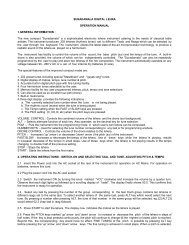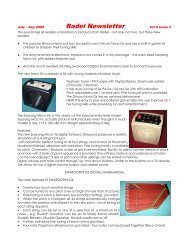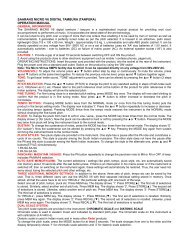You also want an ePaper? Increase the reach of your titles
YUMPU automatically turns print PDFs into web optimized ePapers that Google loves.
RADEL DIGIVEENA – THE DIGITAL VEENA SYNTHESIZER<br />
OPERATION MANUAL<br />
INTRODUCTION<br />
Congratulations! You are the proud owner of a quality product – the unique <strong>Radel</strong> Digi-veena, the first synthesizer based on<br />
an Indian musical instrument.<br />
Uses of the Digi-veena:<br />
Can be used by vainikas for classical concerts.<br />
Vainika-vocalists can use it at ladies’ or gents’ pitch and play comfortably.<br />
Can be used for accompanying choral groups (such as Tyagaraja Pancharatna) at any pitch.<br />
Can also be used as an accompaniment to a vocalist / other instrument at any sruti.<br />
Can be used for recordings of light music / film music / fusion / jazz, as it can be used on any sruti<br />
Can be used for background music recordings / ad spots music tracks by playing as ‘flute’ or ‘saxophone’ etc<br />
FEATURES<br />
Features of the Digi-veena:<br />
Can be used at any pitch without changing strings or tension<br />
All four strings and tala strings tuned automatically and perfectly on selection of pitch through push buttons<br />
Selection of PA or MA for mandara panchamam and taala panchamam strings<br />
String will not change sruti while playing (sruti will not reduce or increase)<br />
Gamakam response adjustment - can be set for high response to smaller deflection of finger or small response to more<br />
deflection. eg., Selection can be made so that with a moderate pull of string , five-note gamakam can be achieved on the<br />
same fret<br />
Enhanced volume, with the amplifier and speaker built-in to one of the gourds<br />
Adjustable volume<br />
Adjustable sustenance of notes; thus long passages can be played with fewer plucks<br />
Adjustable 'sustain' to suit a user's style.<br />
8 'voice' choices (types of sound) – eg; veena, mandolin, saxophone, flute, etc.<br />
Fixed frets on a wooden fret board, eliminating the delicate wax fret board<br />
No setting of melam. Digitally preset fret positions for perfect frequency of each note.<br />
Built-in electronic tambura for sruti<br />
Complete portability, as the sound box of the veena is dispensed with, and replaced by a detachable gourd with an amplispeaker.<br />
Easy assembly / disassembly<br />
Battery back-up in case of AC Mains power failure.<br />
OPERATION<br />
Assembling the Digi-veena:<br />
The instrument consists of a fret-board and two detachable gourds. Fix the detachable gourds to the fret-boards by inserting<br />
the three screws on the bottom of the fret-board into the keyholes on the top of the gourd bracket, with the volume control<br />
facing you in the ampli-speaker gourd, and the tambura controls facing you in the tambura gourd.<br />
Twist the gourds into place just like fixing a light bulb into its socket. Tighten the small locking screw provided below the fixing<br />
bracket of the gourd, to prevent the gourd from detaching accidentally. Connect the two jacks provided below the fretboard to<br />
the sockets seen on the upper metal portion of the two gourds respectively.<br />
Connect the veena to the ampli-speaker gourd with the two connecting cords provided, for the main strings and taala strings<br />
respectively. One end of each connecting cord fits into its socket under the fret-board. The other end of the cord fits into the<br />
respective socket next to the volume control on the ampli-speaker gourd. Connect the mains cord of the ampli-speaker gourd<br />
from the mains socket on the veena (marked AC Mains) to the mains power supply. Connect the wire leading from the tailend<br />
of the veena to the socket marked CTRL SIGNAL on the tambura gourd. The Digi-veena can be used at any voltage<br />
from 90V – 260V AC without using any voltage selector switch.<br />
Playing the Digiveena:<br />
Switch ON the ampli-speaker gourd FIRST and the tambura gourd NEXT. Wait for about 10 seconds.<br />
Adjust the volume of the main and taalam strings to your requirement.<br />
The tambura will play at a default setting of D# (sruti of 2½), indicated as ‘d ●’. On plucking the strings of the veena, all the 4
main strings and the 3 taalam strings will be perfectly tuned for this pitch.<br />
CHANGING THE PITCH: Pressing the upper or lower key under the label ‘COARSE’ will change the pitch in steps of one<br />
semitone (E,F, F#, etc). To fine-tune the pitch, press the upper or lower keys under the label ’FINE’.<br />
SUSTAIN: Adjust the ‘Sustain’ as desired. 4 levels of ‘sustain’ are provided:<br />
0: is the usual sustain found in an acoustic veena<br />
1, 2 and 3 are the three higher levels of sustain provided. ‘0’ is suitable for kriti, taanam and kalpana swaram rendering, while<br />
1 is suitable for alapana. 2 and 3 can be experimented with by the user, for any further requirement of sustain.<br />
SENSITIVITY: Adjust the sensitivity by pressing the keys below the label ‘SENSITIVE’. This adjusts the level of the response<br />
of the strings of the ‘left hand’ to the pull of the gamakam. Levels of sensitivity provided are 5,6,7,8,9 and A. These provide a<br />
range of 5,6,7,8,9 or 10 notes for a pull on a single fret. The default setting is 7 (7 notes). For a vainika used to the acoustic<br />
veena, a ‘SENSITIVE’ level of 7 would be sufficient. These levels can be adjusted over a period of time, according to the<br />
personal preferences of the user. Play and adjust the veena settings as required.<br />
IMPORTANT: Ensure that you wear metal plectrums or pluck the right hand strings with the bare skin of your fingers. Wear a<br />
small metal plectrum for the Taalam strings, as the strings will not respond to the touch of the outer surface of the fingernail.<br />
In extremely dry weather, the right hand fingers, if used without plectrum, may be dampened for better response.<br />
ADDITIONAL FACILITIES OF THE DIGI-VEENA<br />
MADHYAMA INSTEAD OF PANCHAMA: When playing Panchama varja ragas (ragas without panchama) the 2nd string as<br />
well as the panchama string of the talam can be altered to Madhyama. To do this, press both the keys below the label<br />
‘SENSITIVE’ at the same time. This causes a display of ‘-- --‘ on the screen. On strumming the strings, you will find the<br />
panchama string changed to Madhyama. The special feature here is that although the panchama is changed to Madhyama,<br />
the first fret on the second string is STILL SUDDHA DHAIVATA, and all the other frets maintain the same earlier position<br />
when the open string was at panchama. Thus one can play fast passages on ragas like Hindolam, Lalita, Vasanta, Abhogi,<br />
Sriranjani, etc very easily, using the open string for the madhyama in phrases like ‘ma-dha-ni-sa’.<br />
ADDITIONAL TONES: Tones of other instruments can be selected on the digi-veena. Tones provided are: Sitar, Mandolin,<br />
double-string veena, nadaswaram, violin, saxophone and flute. Press the corresponding key to get the respective tone. It is<br />
advisable to keep the talam volume at minimum in the case of the violin, nadaswaram, saxophone and flute.<br />
FACILITY TO ADJUST THE STRING TENSION: Although the tension of the string has no effect on the pitch or gamaka, for<br />
the user’s playing comfort, facility has been provided to tighten / loosen the left hand as well as the right-hand strings. To<br />
adjust the left-hand strings, unscrew the single screw at the far end of the cover on the left side, and tighten / loosen the<br />
screw found at the end of each string. Similarly, tighten / loosen the screw behind the bridge to adjust the tension of the right<br />
hand strings. Recalibrate before resuming play.<br />
RECALIBRATION: If, at any time, the pitch of the veena should go out of tune, press the ‘calibrate’ key once, making sure<br />
that you do not touch the left hand strings or frets. Wait for 3 seconds and resume playing.<br />
DISASSEMBLY: Switch off both gourds after use. Disconnect power cord. Carefully detach the connectors on both gourds<br />
from the fretboard. To disassemble unscrew the locking screws on each gourd. Twist and remove.<br />
USING the DIGI-VEENA ON BATTERY: Recommended: Rechargeable Exide 12V battery no. EP 7-12 ( battery not<br />
included). In case of AC Mains power failure, remove the AC Mains cord and connect the battery cord provided to the socket<br />
market 'DC 12V’. Connect the other end of the cord to a 12V battery pack, ENSURING THAT THE RED LEAD IS<br />
CONNECTED TO THE POSITIVE TERMINAL AND THE BLACK LEAD IS CONNECTED TO THE NEGATIVE TERMINAL OF<br />
THE BATTERY.<br />
CHANGING STRINGS: Although it may not be necessary at all, the following is the simple procedure if ever the strings need<br />
to be changed:<br />
REPLACING TAALAM STRINGS<br />
a) Insert the free end of the spare string through the hole provided on the left side of the taalam bridge.<br />
b) Pull this end and take it through the corresponding hole provided on the right taalam bridge.<br />
c) Loosen the brass nut on the hooking screw and move it forward.<br />
d) Make a small loop at the suitable locking length and lock it on the screw. Tighten the nut till the required string<br />
tension is achieved.<br />
1. REPLACING PLUCK STRING<br />
a) Unscrew the screws on Main bridge and remove the cover.<br />
b) Remove the broken string from the metal socket.<br />
c) Take the spare string and lock the insert end into the metal socket.<br />
d) Pull the string through the mains bridge slot.
e) Loosen the brass nut on hooking screw and place the loop on the hook.<br />
f) Tighten the brass nut till the required string tension is achieved. Fix the main bridge cover.<br />
2. TO REPLACE SENSE (LEFT-HAND) STRING<br />
a) Unscrew the screws on tailpiece cover and remove it. Remove the damaged string from its metal sockets.<br />
b) Lock the insert of spare string into the metal socket provided on hand rest.<br />
c) Loosen the corresponding string holder screw at the tail and lock the other end of the string into it.<br />
d) Tighten the screw till the required string tension is achieved. Fix the tail cover.<br />
WARRANTY: Like all <strong>Radel</strong> products, the Digi-veena carries a warranty of 3 years from the date of sale. This warranty is subject to the<br />
standard terms and conditions of the manufacturer. All users are advised to ensure that the warranty counterfoils attached to this manual are<br />
returned to <strong>Radel</strong> Electronics Pvt. Ltd. within 15 days of purchase. In case of any problems, users are advised to contact the manufacturers<br />
without any delay, giving details of the problem, date of purchase, dealer’s name and purchase document reference.<br />
The manufacturers invite users to feel free to send any feedback, suggestions and special requirements regarding the instrument to them.<br />
The Digi-veena is a very rugged and reliable instrument. The likelihood of failure of components is extremely remote. However, the extreme<br />
sophistication of the technology involved in its design and manufacture make the Digi-veena a Hi-tech product. It is therefore advisable to<br />
contact the manufacturers in case of any problems. Servicing by untrained technicians may cause damage to the sophisticated components.<br />
No periodic servicing is required.<br />
This <strong>Radel</strong> product is supplied with the following free accessories:<br />
a) Power cord<br />
b) User <strong>Manual</strong><br />
c) Carry case<br />
d) spare set of strings<br />
e) battery cord<br />
f) connection cord pair<br />
g) spare knurling screws –2 pcs<br />
For a video demonstration of all features of the Digiveena, go to this link:<br />
http://www.youtube.com/view_play_list?p=8A56AA4F5391EB48<br />
E-mail:<br />
General enquiries: info@radel.in<br />
Service requests: support@radel.in<br />
Website: www.radel.in








